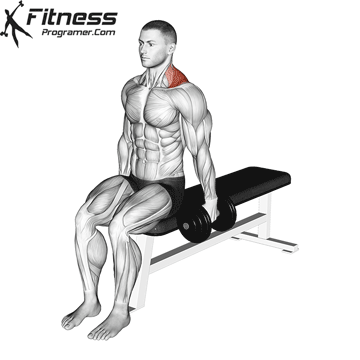Gittleson Shrug Overview
The Gittleson shrug is an advanced variation of the dumbbell shrug designed to specifically target and build the trapezius muscles. The Gittleson shrug emphasizes the contraction of the upper trapezius muscle by isolating the muscle and working it in a one-way fashion. This exercise, with its unilateral focus, can be a valuable addition to a comprehensive training program, especially for individuals looking to address muscle imbalances and target specific areas of the trapezius.
How to do Gittleson Shrug

- Sit on a bench or chair with a dumbbell in one hand.
- Grab the bottom of the bench just behind your hip with your free hand (the one not holding the dumbbell).
- Allow your loaded side shoulder to drop down as far as possible.
- Elevate your shoulder towards your ear, emphasizing the contraction of the upper trapezius muscles.
- Perform the desired number of repetitions on one side before switching to the other.
Tips:
- Use a weight that allows for proper form and control.
- Allow your loaded side shoulder to drop down as far as possible. This puts a stretch on your left upper trap and, because of the way you’re leaning, it also puts an intense isometric contraction in your right upper trap. Although it seems like a one-way exercise, an isometric contraction occurs on the other side as one side moves.
- Stop the exercise if there is any pain or discomfort.
Gittleson Shrug Benefits
- Unilateral Training:
- Addresses muscle imbalances between the left and right sides of the trapezius. Helps ensure balanced development, strength, and size.
- Isolation and Intensity:
- By working one trapezius muscle at a time, you can achieve a more targeted and intense contraction. Isolating the muscle allows for a more focused effort on building strength and size.
- Specific Trapezius Development:
- Targets the individual trapezius muscles separately, promoting specific development and growth. Can contribute to a more symmetrical and aesthetically pleasing physique.
A strong and tight trapezius muscle supports your neck by preventing your head from falling forward and allows you to stand upright. It is a practical exercise that can be applied especially for those who work at the desk in the office.
Gittleson Shrug – Muscles Worked
Here are the main muscles worked during the Gittleson Shrug:

- Trapezius, Upper:
- The upper trapezius is the primary target during the Gittleson Shrug. This muscle is located at the upper part of the back and is involved in shoulder elevation and upper neck movement.
- Trapezius, Middle:
- The middle trapezius is also engaged during the exercise. It is located in the middle part of the back and contributes to retracting and stabilizing the shoulder blades.
- Sternocleidomastoid:
- The sternocleidomastoid (SCM) is a large muscle in the neck that has two heads (sterno- and cleido-). While not the primary target, the SCM may be activated to some extent, especially due to the neck’s involvement in the shrugging movement.
- Levator Scapulae:
- The levator scapulae is a muscle located on the side and back of the neck. It assists in elevating the scapula (shoulder blade) and is also involved in neck movement.
Functional Roles:
- The trapezius muscles, both upper and middle portions, play a crucial role in shoulder and neck movement, including elevation, retraction, and stabilization of the shoulder blades.
- The sternocleidomastoid and levator scapulae contribute to neck movement and shoulder blade elevation.
